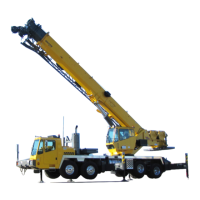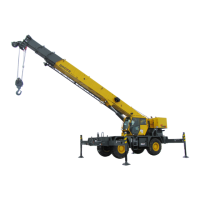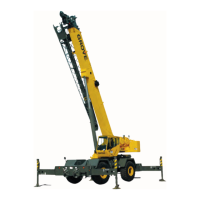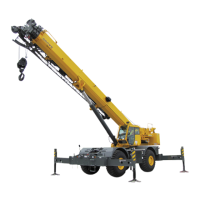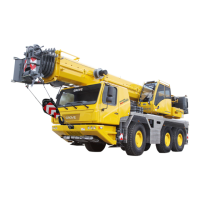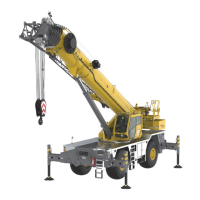GROVE 6-33
TMS9000-2 OPERATOR MANUAL SET-UP AND INSTALLATION
Published 02-21-2019, Control # 611-05
The hoist rope can be reeved differently depending on the
required lifting capacity.
The lifting capacity of the crane depends, among other
things, on the tractive force of the hoist and the number of
reevings on the hook block. The lifting capacity is never
greater than the tractive force of the hoist times the number
of rope lines between the boom head and the hook block
(minus the amount of friction);
When determining the required lifting capacity, please note
that the weight of the hook block and the lifting gear must be
added to the load. The actual useful load is therefore less
than the value specified in the table.
Rope end clamp
A rope end clamp is fastened to the end of the hoist rope.
The rope end clamp can be attached to the hoist rope end; it
is also possible to reeve the rope with the clamp attached.
If the hoist rope is bearing a load, the rope end clamp always
aligns itself so that the point (2) at which the carrying rope (1)
ends in the rope end clamp is on the same axis (X-X) as the
slinging point (3) (pulling axis).
Always thread the hoist rope so that the carrying rope runs
along this pulling axis and is not kinked when under a load.
The hoist rope is correctly threaded if it runs into the rope
clamp at position (2) and the free end projects out of the rope
end clamp at position (4).
rope wedge is needed for attaching the rope end clamp. The
rope end clamp and rope wedge are labeled with their
respective sizes and corresponding rope diameters. Ensure
that the rope wedge inserted into the rope end clamp is
DANGER
Crush Hazard!
The use of an incorrectly sized wedge can allow the rope
to slip and the block and load to fall. Death or serious
injury could occur.
